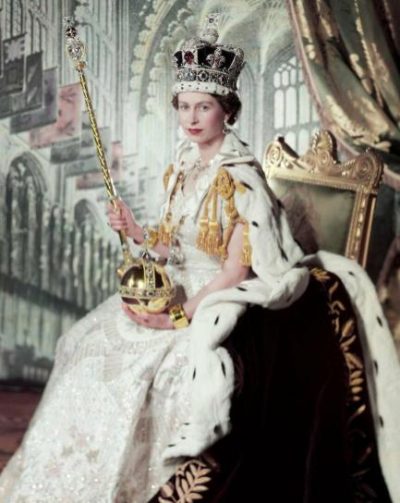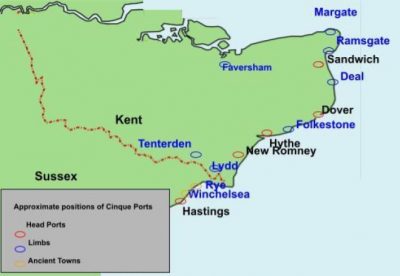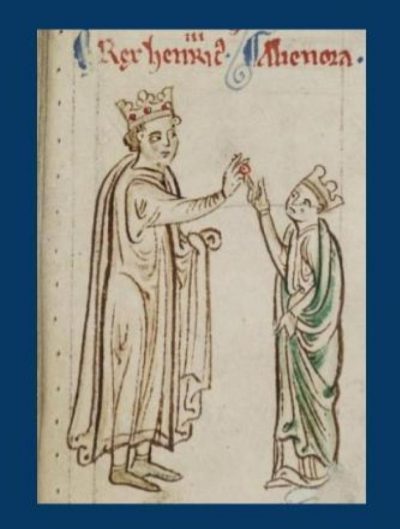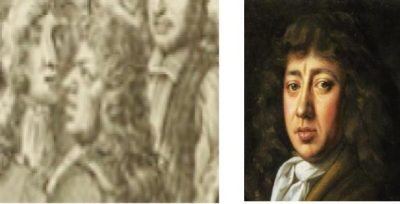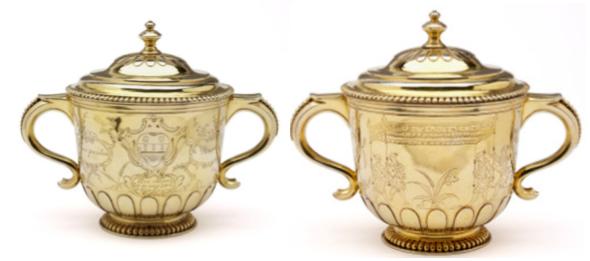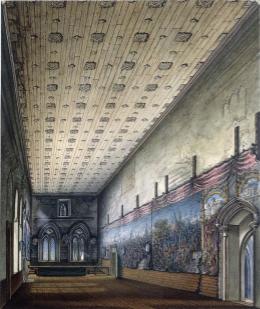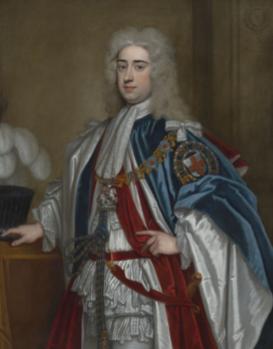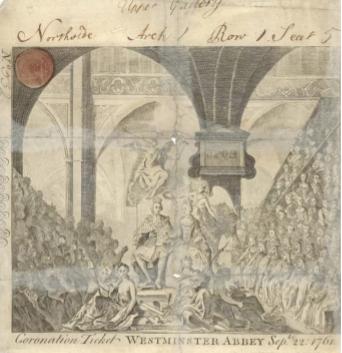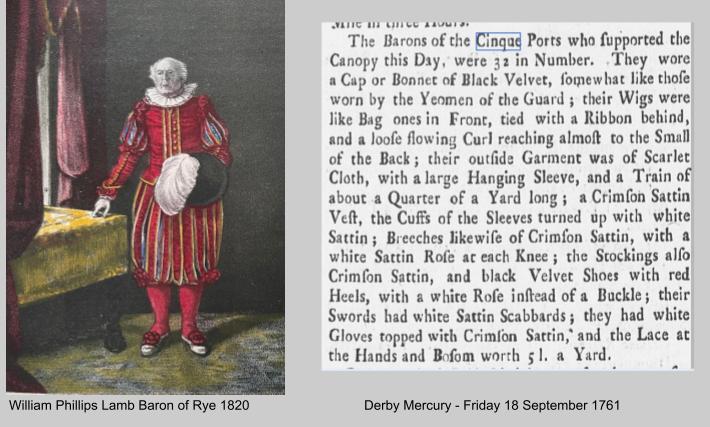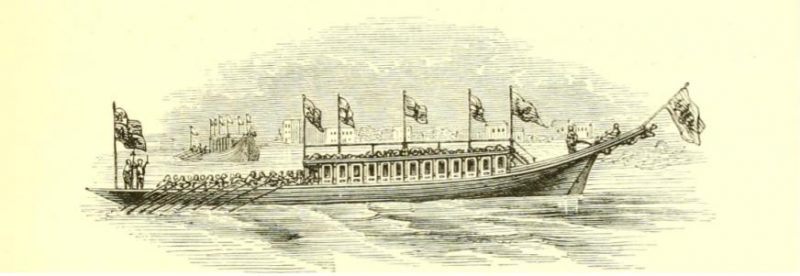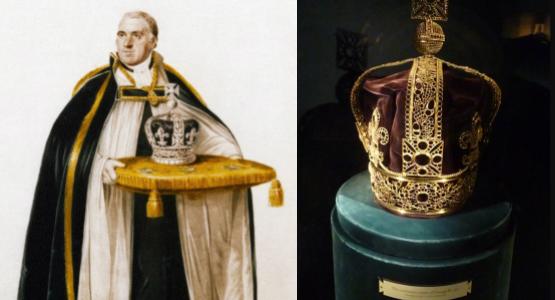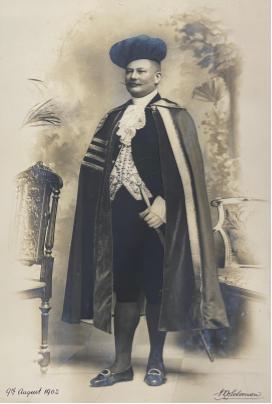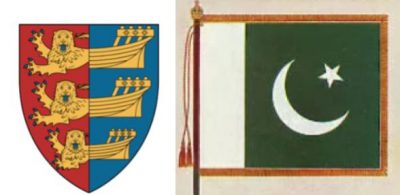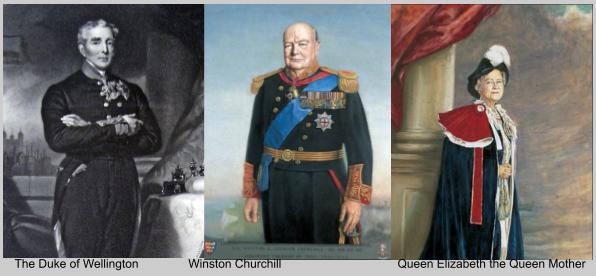Follow us on Facebook @FHofDW
The Coronation
and the
Barons of the Cinque Ports
On June 2nd 1953 the coronation of Queen Elizabeth 11 took place in Westminster Abbey. At her coronation, as in most since mediaeval times, the Barons of the Cinque Ports had the honour and privilege to take part.
This has on many occasions included a Baron from Deal or at least with a link to the town.
The Freemen of the Cinque Ports were once known as portsmen or Barons. In modern times Freemen has become an honorary title being bestowed upon the likes of Winston Churchill in 1951, certain former Mayors of the town and the Royal Marines in 1945. The use of Baron has survived becoming a ceremonial title used by those elected to represent the ports such as the Member of Parliament or, as is more common in recent times, the Mayor.
Coronation Privilege
This privilege of taking part in the coronation ceremony of the monarch dates back to at least 1236 and the coronation of King Henry 111 and Queen Eleanor of Provence. Chronicler Matthew Paris writes that The Barons of the Cinque Ports ‘carried over the King and separately the Queen purple silk cloths supported by four silver spears with four little silver gilt bells.’
It may even date back to 1189 and the Coronation of Richard 1 when, Roger of Hoveden another chronicler, wrote that ‘On four lofty spears a canopy of silk was held above the Kings head by four Barons.’
The privilege of carrying the canopy continued down through the centuries with little deviation. Even Shakespeare mentions it in his Henry the Eighth where, at the coronation of Queen Ann when one gentleman says to another.
“They that bear The cloth of honour over her, are four barons of the Cinque-ports.”
Samuel Pepys left us his first hand description after watching the coronation of Charles 11 from a structure within Westminster Abbey.
“Here I staid walking up and down, and at last upon one of the side stalls I stood and saw the
King come in with all the persons (but the soldiers) that were yesterday in the cavalcade;
and a most pleasant sight it was to see them in their several robes.
And the King came in with his crown on, and his sceptre in his hand, under a canopy borne up by six silver staves, carried by Barons of the Cinque Ports, and little bells at every end”.
As happens at all big events occasionally things do not always run smoothly. Pepys comments on and shares a description by Bishop Kennett of an “unseemly tussle” in Westminster Hall where the coronation banquet was held. Bishop Kennett says that after the Barons had brought the King, under his Canopy, to the foot of the stairs the King’s Footmen “insolently and violently seized the Canopy” from the Barons who, not willing to relinquish what they considered to be theirs by right, were dragged down the hall. A Herald being near the door shut it thus preventing escape. The King, being informed sent an order “to imprison the footmen, and dismiss them out of his service”.
The Bishops and judges, taking advantage of this disturbance, then took the places reserved for the Barons, as was their privilege, on the first table to the right of the Kings. They, not wanting to miss out on their dinner, had to sit lower down on the second table.
During the dinner the canopy and staves were put into the hands of Sir R Pye until the dispute was settled with the canopy and staves being eventually delivered back to the Barons.
By the time of James 11 coronation Samuel Pepys had been elected MP for Sandwich, so he, as one of Baron of the Cinque Ports, carried one of the staves of the canopy over the King.
This etching shows the procession – with Pepys on the front left corner carrying a stave supporting the Coronation Canopy. The bells can be seen hanging from the corners of the canopy.
This 3in (7cm) silver-gilt George II bell by Francis Garthorne, London c.1727.
The inscription reads
“One of the bells belonging to the canopy born over King George the Second at his Coronation.”
The canopy, silver staves and bells were all provided by the Lord High Steward, or Treasurer, and these were ‘retained by the Barons as their fee’. Some bells have survived but, others over the years, with the staves, have been melted down to make other commemorative objects. This silver gilt cup, held by the V&A is just one such item. On one side you can just make out four Chinoiserie style figures carrying a canopy.
George 111
The Proceedings of the Cinque Ports Barons’ compiled in 1820, by T. Mantell, is a record of the Baron’s attendance at the Coronation of George 111 in September 1761. It includes the various communications and applications made and received by the Barons, before the coronation and details the order of events that lead up to and beyond the coronation itself which sadly did not run at all smoothly.
The main points of which were-
- On the announcement of the date of the coronation a letter was sent from the Cinque Ports elected Speaker, to the Mayors and Jurats of the ports, asking for their choice of a ‘proper persons’ to be Barons. This was needed, so they could make their claim for the canopy service. John Dilnot, surgeon of Sandwich and Lord of the Manor of Chamberalins fee in Deal, was one of those duly nominated.
- When all the ports nominations were received a petition was then sent via the ports solicitors to the Court of Claims which is a special court established after the accession of a new sovereign to judge the validity of the claims of the people wanting to perform honorary services at the coronation.
- The Court of Claims, held in the Painted Chamber, granted all but the money for ‘…vestments at His Majesty’s expense…’
- A request was then sent to the Lord Warden asking for his assistance to gain admittance to the coronation to perform the service and receive the honours (carrying the canopy and the right to dine at the banquet) and fees (to receive the canopy, staves and bells) due to them.
- The Lord Warden replied ordering them to submit the names of those “…fitly qualified to be bearers of the canopies at the said Coronation…”
- Duly sent it was then ordered that the Solicitors apply to the Lord Great Chamberlain for their tickets. It was also ordered that a petition be presented to His Majesty to be admitted to dine at the principle table next to their Majesties on their right hand.
- They were then ordered to dress in a particular way using certain fabrics. The description of the Barons vestments at the Coronation of George 111 are very similar to those worn at the coronation of George 1V. As was also their privilege, they were “…ordered, that when the King puts on his Crown , every Baron put on his Cap, and continues it on the rest of the Ceremony…”
- An application was then made by the Barons to the Warden of the Stationers Company for their barge to carry them from York Stairs to Parliament Stairs and for the Barons to meet at the Salt Office to robe and embark to the barge.
With the right to dine not being granted an appeal was lodged. However, on the great day the Barons heard again that no table was provided for them so they applied to the Lord High Steward, William Talbot he, though “… absolutely refused and told them they should not dine in the Hall..”
After the six hour coronation ceremony, The Barons, all thirty-two of them, went and stood together in the hall at the upper table, to the right of the King’s, but even then no table was offered to them, and they were not alone in this, so they returned to the Salt Hall.
The next day they met and prepared a letter of protest stating that it was a unanimous opinion that the rights and privileges of the Barons had been “…highly violated…”
It is recorded that the banquet was so badly organised that some invited guests had nowhere to sit. Lady Northumberland complained “… No dinner to eat, shameful experience…no wherewithal to fill one’s belly…”
Other mishaps occurred during the coronation ceremony itself. The Sword of State was mislaid, no chairs had been provided for the King and Queen in the Abbey, so replacements were hastily sought, and no canopy was held above them, the Heralds, acting as ushers, new nothing of the order of aristocratic precedence and the King often had to call out to correct matters. A dress rehearsal would no doubt have been very useful had it occurred.
By tradition, ceremonial preparations were conducted by the Earl Marshal. Edward Howard, 9th Duke of Norfolk though, as a Roman Catholic, was debarred. He therefore deputed the role to Thomas Howard, 2nd Earl of Effingham. He was brought before the King to explain the many mistakes of the day by way of apology he said “ …that the next Coronation would be conducted with the greatest order imaginable…”. Far from being offended by this the King thought it so funny he asked the Earl to repeat it.
George IV
The last time that the Barons actually carried the canopy was at the coronation of George IV in 1821.
The planning for this coronation included not permitting the king’s estranged wife, Caroline of Brunswick to have the “…privilege of seeing the coronation…” . The King, it is stated “… was determined that the Queen shall form no part of the ceremonial of his coronation and that the Queen shall not attend the said ceremony…”
This coronation was nonetheless perhaps one of the most extravagant, costing a staggering £230,000, which today is approximately 13 million pounds. King George had a crown specially made for the coronation containing over 12,000 diamonds which cost over £24,000 pounds to hire. Despite the King’s pleas to his government they refused to buy it outright so it was dismantled and sold two years later. The king though had a copy made out of bronze costing a mere £38, on which an inscription reads “Cast of the Rich Imperial Diamond Crown with which His Most Sacred Majesty King George IV was crowned on 19 July 1821” Now devoid of any jewels it is in the Royal Collection.
Despite the planning for this grand extravagance, not all things went as they should. The manuscript with the coronation oath on it, which the King was to sign, could not be found when needed. An Order of Service was quickly produced to cover the mishap which he signed instead. The King was then supposed to process from Westminster hall to the Abbey with the Barons of the Cinque Ports carrying the canopy over him. George IV, though, decided to walk in front of the canopy instead!
William IV
William IV, did not invite the Barons to his coronation perhaps because he wanted a modest affair. This upset many Peers who actually threatened to boycott the Coronation entirely! The King though was not to be entirely swayed so in the interest of keeping the costs down it was agreed that there was no Coronation banquet afterwards.
Edward VII
Queen Victoria also neglected to invite the Barons but her son Edward VII reinstated the tradition and invited them to attend his coronation in 1902. This time though they did not bear the canopy but were stationed either side of the entrance to the quire where they were entrusted with the Standards of England, Scotland, Ireland and the Union returning them to the standard bearers after the ceremony.
Mayor Walter Joseph Solomon represented Deal as a Baron of the Cinque Ports. On arriving at Westminster Abbey they were first stationed at the Peers entrance at the Great West Door. At 10.30 they were summoned by the Earl Marshal and processed through the Nave to their positions, nine on each side, at the Quire Entrance. Four Barons were charged with receiving the Standards of the Union from the standard bearers.
As the King passed by the Barons they dipped the standards in a salute. The Standards being returned at the closing of the ceremony.
In 1911 at George V Coronation James Edgar attended and the Barons on that occasion too had the charge of the Standards during the ceremony. This now seems to have become the privilege of the Barons as in 1937 at the coronation of George VI they were honoured to do the same with Mayor John Grice Tooms representing Deal.
Elizabeth II
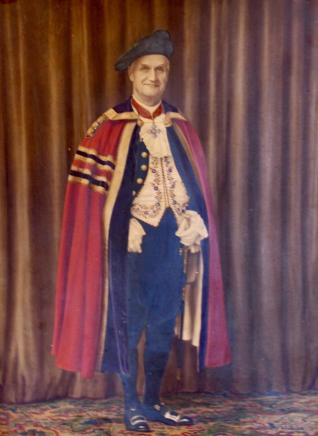
Baron of Deal Mayor Frederick Felix Potter note the Badge of the Cinque Ports on his right shoulder Deal Museum P-U/4/6
Elizabeth 11
Frederick Felix Potter in 1953 had the honour to attend the Coronation of Queen Elizabeth 11 when, according to the records of the Cinque Ports they were allotted the west side of the screen and that the standards borne in the Royal Procession were handed to the Barons for safe keeping during the ceremony and returned as the ceremony closed. Deal’s Baron (Mayor) Potter was handed the Pakistan standard by Mirza A H Ispahani who, as a Diplomat and Politician, represented his country as part of the Commonwealth.
Walmer Castle has been the official residence of the Lord Wardens of The Cinque Ports since 1728 when Lionel Cranfield Sackville, 1st Duke of Dorset first made use of the former captain of the castle’s quarters there. Lord Wardens both before and since have attended the monarch’s coronations but not always as The Lord Warden of the Cinque Ports who usually hold other ranks, the most notable being, the Duke of Wellington, Winston Churchill and Queen Elizabeth the Queen Mother.
Charles III
Now in 2023 with the Coronation of King Charles taking place on Monday, May 8th it is again time for a Baron from Deal to be nominated and as such The Worshipful Town Mayor of Deal, Councillor Chris Turner, will follow his predecessors and attend the Coronation of King Charles III on behalf of the people of Deal as a Baron of the Cinque Ports.
